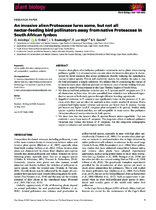An invasive alien Proteaceae lures some, but not all nectar-feeding bird pollinators away from native Proteaceae in South African fynbos
Abstract
Invasive alien plants often influence pollinator visitation to native plants when sharing pollinator guilds. It is of conservation concern when the invasive alien plant is characterized by floral resources that attract pollinators, thereby reducing the reproductive success of native species. This is well studied for insects, but whether the same is true for bird pollinators is largely unknown. We address this by considering the impact of an invasive alien plant (Banksia speciosa) on visitation rates of nectar-feeding bird pollinators to native Protea compacta in the Cape Floristic Region of South Africa.
We determined bird pollinator visitation rate to B. speciosa and P. compacta over 21 h of observation at three sites. We also quantified how visitation rate influenced reproductive success of both study species through different breeding experiments.
• Sugarbird visitation to P. compacta was significantly lower in the presence of B. speciosa, while there was no effect for sunbirds as they mostly avoided B. speciosa. Protea compacta had higher nectar volumes and sucrose per flower than B. speciosa. Sucrose per hectare was higher in all P. compacta plots compared to B. speciosa. Neither study species is pollen limited and they are self-compatible to some extent. But pollinator visitation enhanced seed production in both species. We show here that the invasive alien B. speciosa flowers attract sugarbirds – but not sunbirds – away from native P. compacta. The long-term effect of reduced pollinator visitation may reduce the fitness of P. compacta, but the long-term demographic impact is unknown and would require further study.

